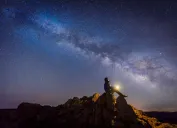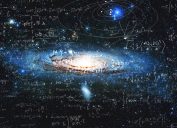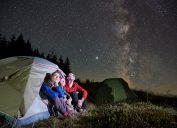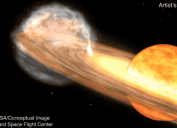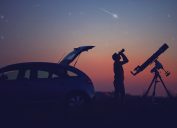"Very Rare" Solar Storm May Bring the Northern Lights to 23 States This Weekend
The spectacle could be visible as far south as Alabama, the NOAA says.

There's been no shortage of cosmic events in 2024, between a meteor shower, a "devil comet," and, of course, April's total solar eclipse. But this weekend, people across the U.S. may be treated to yet another spectacle. A "very rare" solar storm could allow millions of Americans to see the northern lights. These colorful bursts are normally restricted to the most northern regions, but this time, people across approximately 23 states—including a few that are a bit farther south—may want to head outside.
RELATED: 8 Best Places to See the Northern Lights in 2024.
Yesterday, the National Oceanic and Atmospheric Administration's (NOAA) Space Weather Prediction Center (SWPC) updated a geomagnetic solar storm watch from "moderate" (Level 3) to "severe" (Level 4). This is the first "severe" Geomagnetic Storm Watch issued since Jan. 2005, the agency added in a separate alert.
The alert notes that the sun has sent at least five coronal mass ejections (CMES)—explosions on the sun—toward Earth. This may trigger nighttime auroras when they reach Earth's magnetic field, an event otherwise known as a geomagnetic storm.
If ejections merge, the storm could be even stronger. According to the May 9 alert, the CMEs are expected to do just that and "arrive at Earth by late on May 10th or early on May 11th," lasting through Sunday.
NOAA notes that "watches at this level are very rare," also calling it "an unusual event" in the separate alert.
While Canada and Alaska have the best chances of seeing the northern lights, those in the contiguous U.S. may also be in for a sighting. According to the latest SWPC aurora forecast, those in the northern areas of Washington, Idaho, Montana, Minnesota, Wisconsin, and Michigan, as well as those in most areas of North Dakota, have the highest likelihood of catching a glimpse.
RELATED: 8 Amazing Things You Can See in the Night Sky Without a Telescope.
There's a lower probability, but still a chance, to see the lights from Oregon, Wyoming, South Dakota, Nebraska, Iowa, Illinois, Indiana, Ohio, Pennsylvania, New York, Connecticut, Rhode Island, Massachusetts, Vermont, New Hampshire, and Maine.
Even more exciting, the NOAA says that the lights could be visible as far south as Alabama and northern California. If this occurs, the auroras might be visible in surrounding states in the West and Midwest. Illustrating this, an aurora forecast map from the Geophysical Institute at the University of Alaska Fairbanks—which incorporates data from the NOAA based on long-term data—shows that regions of Oklahoma, Virginia, and South Carolina, among others, could also see the lights.
However, you do need to take the weather into account, as clouds can obstruct your view. According to Fox Weather, clouds will be present in the Northeast today and tomorrow morning. But clear skies are set for most of the northern U.S., with less than 10 percent cloud coverage predicted for the Midwest across the Northwest.
RELATED: 5 Places Where You Can See More Solar Eclipses in the Coming Years.
Still, getting outside and looking for the lights may be worth it. The SWPC notes that it also needs to be dark to see the aurora, so go outside in the evening and try and get away from city lights if you can. The best timing is typically within one to two hours of midnight, so between 10 p.m. and 2 a.m. local time.
"These hours of active aurora expand towards evening and morning as the level of geomagnetic activity increases," the agency explains. "There may be aurora in the evening and morning but it is usually not as active and therefore, not as visually appealing."
If you don't get out tonight, "stay tuned" on Saturday and Sunday, Rob Steenburgh, a space scientist at SWPC, told The Washington Post.
"Depending on how these [coronal mass ejections] are staggered, you can expect the activity to last longer," Steenburgh said. "Our expectation and the modeling do suggest that they kind of catch up with each other."



